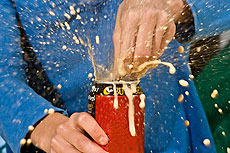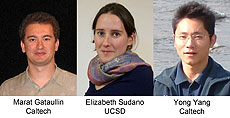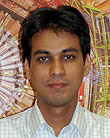|
Have a safe day!
Friday, Oct. 14
3:30 p.m.
DIRECTOR'S COFFEE BREAK - 2nd Flr X-Over
4 p.m.
Joint Experimental-Theoretical Physics Seminar
Speaker: Anyes Taffard, University of California, Irvine
Title: New Results from ATLAS
8 p.m.
Fermilab Lecture Series - Auditorium
Tickets: $7
Speaker: Dr. Tony Wasserman, Carnegie Mellon University
Title: The Rise of Free and Open Source Software
Monday, Oct. 17
2:30 p.m.
Particle Astrophysics Seminar - One West
Speaker: Oscar Agertz, University of Chicago
Title: Recent Advances in Computational Galaxy Formation
3:30 p.m.
DIRECTOR'S COFFEE BREAK - 2nd Flr X-Over
4 p.m.
All Experimenters' Meeting - Curia II
Special Topics: Tevatron Decommissioning Plan; Centrifugal Barrel Polishing for SRF Cavity Processing
Click here for NALCAL,
a weekly calendar with links to additional information.
Upcoming conferences
|
|
Friday, Oct. 14
- Breakfast: Chorizo burrito
- Smart cuisine: Italian vegetable soup
- Chicken fajita sandwich
- Southern-fried chicken
- Smart cuisine: Mediterranean baked tilapia
- Eggplant parmesan panini
- Assorted sliced pizza
- Assorted sub sandwiches
Wilson Hall Cafe Menu
|
|
Friday, Oct. 14
Dinner
Closed
Wednesday, Oct. 19
Lunch
- Garlic soup
- Muffuletta
- Bread pudding w/ bourbon sauce
Chez Leon Menu
Call x3524 to make your reservation. |
|
Email, network and power outage – all day tomorrow
Tomorrow, Saturday, Oct. 15, the Computing Sector facilities management team and the Facilities Engineering Services Section will conduct a scheduled power outage necessary to complete the final steps of the Feynman Computing Center (FCC) cooling upgrades. The outage will effect all computing and network services.
This outage will begin at approximately 3 a.m. and will last most of the day. All systems dependent upon FCC facilities will be affected. Email services and the wireless network will be unavailable for the duration of the outage. Wired network and Internet access will be available in Wilson Hall. The network is scheduled to be back to full operation around 2:30 p.m., and other services should be back by approximately 5 p.m.
Facilities management expects this outage to last no more than eight hours. You can get updates by:
- following the Service Desk Twitter feed, @FNALServiceDesk,
- visiting the Service Desk on the ground floor of Wilson Hall,
- or calling the Service Desk at 630-840-2345.
|
Wayne Waldon - retired Oct. 7
It was a high school teacher in Georgia who prompted Wayne Waldon to consider a career in science. More than 40 years after that conversation, Waldon retired from the Mechanical Department of CDF operations at Fermilab on Oct. 7.
“My high school teacher junior and senior year said I should go further in physics,” Waldon said.
He took his teacher’s advice and studied physics at Clark College in Atlanta. It was there he first heard about Fermilab from a recruiter visiting colleges.
In 1972, he came to the laboratory to work for the summer. He liked what he saw and forged some friendships and connections in the community. The next year, he became a permanent employee. Wilson Hall was not yet completed and the personnel offices were still located in a farmhouse.
“That first year I thought I would freeze to death,” said Waldon, who, after 38 years at Fermilab, still has a hint of a southern accent.
He worked on a variety of projects over nearly four decades, and most recently worked in the Mechanical Department of CDF operations handling the electrical and electronic controls for the process systems.
Read more
—Victoria Pierce
|
New SuperB factory particle-accelerator project launched in Italy
From PhysOrg.com, Oct. 12, 2011
The SuperB factory, a particle-accelerator to be built in Rome and approved last May by the Italian government was officially launched this past Friday with construction set to begin sometime in the near future. The accelerator, which is expected to take six years to build, will be constructed on the University of Rome Tor Vergata campus and will be named for the late Nicola Cabibbo, the Italian physicist best known for his work with weak force interactions.
The particle-accelerator, known as a B-type factory because it will send electrons and positrons (antiparticles) around a track, will be 1.3 kilometers long. The two particles will be made to collide producing what is known as heavy B mesons. Physicists studying them and how they decay hope to find answers to questions such as to why there appears to be less antimatter than matter in the known universe.
The project is one of 14 the Italian government has approved as part of its CIPE Economic Planning Document. Championed by the Istituto Nazionale di Fisica Nucleare (INFN), the accelerator will span 30 hectares on the university campus and will be within shouting distance of INFN Frascati National Laboratories.
Read more
|
Ambitious Hubble survey obtaining new dark matter census
From Hubblesite.org, Oct. 13, 2011
Cluster MACS J1206.2-0847 (or MACS 1206 for short) is one of the first targets in a Hubble Space Telescope survey that will allow astronomers to construct the highly detailed dark matter maps of more galaxy clusters than ever before. These maps are being used to test previous but surprising results that suggest that dark matter is more densely packed inside galaxy clusters than some models predict. This might mean that galaxy cluster assembly began earlier than commonly thought. The multiwavelength survey, called the Cluster Lensing And Supernova survey with Hubble (CLASH), probes, with unparalleled precision, the distribution of dark matter in 25 massive clusters of galaxies. So far, the CLASH team has completed observations of six of the 25 clusters. MACS 1206 lies 4.5 billion light-years from Earth.
Read more
|
|
Lepton fizz
 |
|
While one can safely open a can of soda, if you add energy to it by shaking it, it will fizz all over. If the familiar electron and muon turn out to be made of smaller objects, we can add energy to them, which might be emitted as photons.
|
Grab a can of soda, shake it thoroughly, and open it up. What do you get? It’s an explosion of fizz. Today’s column is about a similar thing in the subatomic world.
Scientists have spent centuries searching for the ultimate building blocks of matter. And they first found that molecules gave way to atoms. Then, in the early 1900s, scientists realized that atoms were actually composed of smaller particles called protons, neutrons and electrons. And about 50 years ago, scientists realized that the protons and neutrons were themselves made of quarks. The electron has resisted all attempts to find a smaller object that contains it and it is now classified as a lepton, a label that also includes the muon and tau lepton.
As of this article, it appears that the quarks and the leptons are the smallest objects in nature… objects that are point-like, which means they contain nothing inside them. With the right mix of these particles, we can construct the entire universe. This understanding is called the Standard Model and is rightfully considered a triumph of human ingenuity.
However, if history teaches us anything, it teaches us that we don’t know everything. It is entirely reasonable to ask if these familiar building blocks are made of even smaller things. If they are, it is possible to pump energy into a quark or lepton. That energy will then be emitted and detected. This is kind of like how you can safely open a can of soda, but if you pump energy into it by shaking, it will fizz all over. Analogously, the CMS experiment searched for excited electrons or muons, which emit a photon and then settle down into one of our familiar particles.
Events containing a lepton and photon are expected from understood physics. However, if we found an excess of events where the lepton and photon came from a parent particle with a specific mass, this would be powerful evidence that we have discovered an even smaller particle. It’d be another layer in the subatomic onion. Such a discovery would have profound impact on our understanding of the world. While this study found no evidence for excited leptons, it was done with about one percent of the data recorded so far. This paper surely isn’t the last word we’ll hear about excited leptons.
—Don Lincoln
 |
| These physicists contributed to this analysis.
|
 |
|
Sushil Singh Chauhan from UC Davis has been taking care of the online beam position determination. This is important feedback from CMS to the LHC and also important for triggers that look for tracks that don’t originate directly from the collision. |
|
|